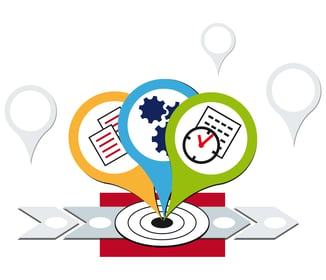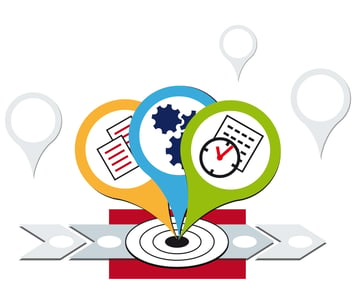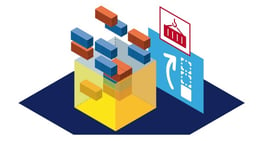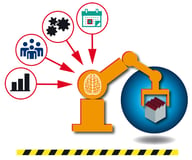5 Surprising Facts About Logistics 4.0
Brian Hoey - March 14, 2019

 Logistics 4.0: buzzword, or critical concept for the future of supply chain management? We might be a little bit biased over at flexis, but we’re pretty sure it’s the latter. As the global supply chain becomes every more complex and ever more digital, businesses are going to need a new framework for making decisions, developing shipping plans, and creating cohesion between their various IT choices. We think that Logistics 4.0 is going to provide that new framework, and we think that after you’ve had a chance to peruse some of these interesting facts, you’ll heartily agree.
Logistics 4.0: buzzword, or critical concept for the future of supply chain management? We might be a little bit biased over at flexis, but we’re pretty sure it’s the latter. As the global supply chain becomes every more complex and ever more digital, businesses are going to need a new framework for making decisions, developing shipping plans, and creating cohesion between their various IT choices. We think that Logistics 4.0 is going to provide that new framework, and we think that after you’ve had a chance to peruse some of these interesting facts, you’ll heartily agree.
1. Logistics 4.0 isn’t just a branch of Industry 4.0
Now, one of the most common misconceptions about Logistics 4.0 is that it’s just an offshoot of its more visible and more widely talked about partner, Industry 4.0. While the two are certainly related (and even operate on the same principles of digitization, interconnectivity, and visibility), Logistics 4.0 isn’t simply an outgrowth of this modern manufacturing process. Rather, it’s an important paradigm in its own right, combining data-driven shipping and freight forwarding workflows with the kind of radical visibility that’s already changing the world of manufacturing. It enables transport planners to gain a comprehensive look at the entire supply chain and thereby generate smarter routes and tours—routes and tours that can be adapted to changing circumstances in order to preserve maximum value in the face of disruptions and lower overhead through increased leanness and agility. Even if the term Industry 4.0 had never been coined, these processes would have been critical for the ongoing success of transport planners in the digital age.
2. …But it is especially effective when paired with Industry 4.0 systems
Of course, just because Logistics 4.0 has a standalone value outside of the context of Industry 4.0n doesn’t mean that two can’t be mutually value additive when integrated. Imagine for a second that you’re a shipper with an automotive manufacturer as a client. Their systems are still not largely digitized, which means that there are virtually no opportunities for IT integration between your two organizations. As a result, there are essentially no data streams at your disposal for creating synergistic links between customer requirements, production workflows, and transport processes. You can create the routes from their warehouse to the final customer destinations in a way that maximizes efficiency, but if something deviates from your plan on your client’s end it might prove difficult to gain enough visibility into the issue to take effective steps to address it.
Contrast this with an Industry 4.0-enabled client. Because your two organizations are sharing data in real-time, you can gain a comprehensive view of resource availability as it changes. If your manufacturing partner looks like they're unlikely to finish a production run on time, you can scrutinize the available data in order to determine the optimal solution. Should you opt for a milk run or a less-than-full truckload, or is it worth your time to wait until the entire shipment is ready? Answers to these questions and others could prove to be latent in the combined data your two organizations are sharing.
3. Logistics 4.0 processes are empowered by smart containers, smart pallets, and smart ports
We spoke above about the ways that Logistics 4.0 processes enhance visibility towards the aim of creating a more adaptive and agile supply stream—but how does that actually happen? Essentially, planners in Logistics 4.0 environments are able to collect real-time data from multiple sources across the entire value chain via IoT (internet of things) and RFID integration. In practice, this takes the form of each element of a given logistics chain, from trucks and containers all the way down to pallets and other pieces of warehouse equipment, being equipped with an IoT device or RFID chip such that it can transmit live data back to a central logistics control tower. In this way, shippers and freight forwarders can create a real-time digital view of their entire operations, one that indicates the position of each piece of cargo within its greater journey through the value stream. What utility does this offer? Simple—it lets logistics planners monitor their operations for potential disruptions or potential untapped efficiencies. For example, if you see that a particular warehouse within your network contains many of the goods that are required for a shipment that would usually be carried out from a different warehouse, you can reorganize your shipment to take advantage of that fact by bundling your freight loads in a more efficient manner.
4. Logistics 4.0 is fundamentally proactive, rather than reactive
Hopefully, you’ve gotten the sense so far that one of the most important ways Logistics 4.0 provides value is by giving you a comprehensive overview of the resources that are at your disposal as you administer your supply chain. But where exactly does the value-add come from here? In a perfect world, it takes the form of a fundamentally more proactive value chain. Instead of using incomplete, outdated information to respond reactively to situations as they arise, Logistics 4.0 supply chains can use advanced predictive analytics to more closely match their operations to likely future scenarios in advance. By the same token, they can digitally map their value chains in order to find potential process improvements before disruptions occur. In this way, Logistics 4.0 drives shipping and freight-forwarding workflows that look ahead to to potential disruptions and future changes in market conditions.
5. …Which is why it’s not just a passing fad
Like we said above, we don’t think that Logistics 4.0 is a fad or a buzzword. And based on the last few paragraphs, we hope that we’ve been able to demonstrate why. Anything that enables planners to stay one step ahead of any potential supply chain events isn’t likely to go anywhere any time soon. Likewise, any system that fits so neatly with the principles of Industry 4.0 (which are each year gaining in prominence and adoption) is likely to continue to be a part of global supply chain management going future. Logistics planners and supply chain managers ignore this increasing trend towards visibility and digitization at their own peril.
LATEST POSTS
- Understand Why Production Planning Needs Specialized Solutions
- Understand Circular Economy in The Manufacturing Industry
- How Can Industry 4.0 IT Integration Be Achieved Smoothly?
- The Significance of Order Sequencing in Discrete Manufacturing
- How to improve your Supply Chain Management: The Power of Control Towers



